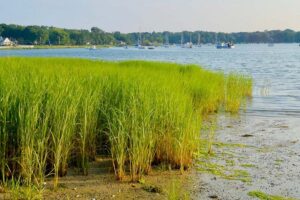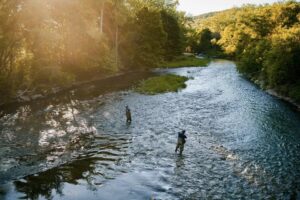Because four members of the MA Fish & Wildlife Board are new members this year, it seemed appropriate that the Division of Fisheries and Wildlife inform and educate them as to what the Division’s Wildlife Program is all about. Hey, it’s a good time for us to learn about it too. The following are excerpts of a report that Assistant Director for Wildlife, Michael Huguenin made to the Board at its January meeting, minus the charts which he used.
Mr. Huguenin reported that the Wildlife Section’s mission is to conserve and manage wildlife populations and habitats, and to enhance wildlife-based recreation and public appreciation of wildlife. Wildlife conservation and management and public service are the section’s priorities. To serve those priorities, its staff consults and reviews the best available science, and conducts population research, monitors for disease, and tracks harvest trends. Wildlife staff also tracks human-wildlife conflicts, conducts annual surveys that go back decades, participates in a myriad of other R3 (recruitment, retention and reactivation) and relevancy efforts, and contributes to MassFishHunt’s ongoing development.
Mr. Huguenin noted that when data has been collected, the biologists combine that information with the collective experience and professional judgement of Wildlife staff and senior staff to initiate management actions, such as regulation reviews, outreach strategies, habitat management, and surveys, and to develop and manage programs such as crossbow permitting, falconry, PAC [Problem Animal Control] permits, pheasant stocking, and LART [Large Animal Response Team].
M.G.L. Chapter 131 and 321 CMR 2.00 and 3.00 really govern all the Wildlife Section’s work. The law provides MassWildlife with its authority to fulfill its mandate. Mr. Huguenin reported that the single most important piece in the conservation puzzle is the law. Further, he noted that Chapter 131 gives MassWildlife the authority to create regulations and permits that dictate the manner in which one can take, possess, or impact wildlife. In turn, the research and monitoring that the science staff conducts are essential to informing those regulations and permit parameters for conservation and management, just as they inform other management actions.
Assistant Director Huguenin reported that the team the Wildlife section has to accomplish all of this is not very big, but it gets a lot done. He noted that the Wildlife section also houses the six Habitat Program staff, and that the Habitat Program has grown and evolved over time, and essentially serves all sections in the agency.
Huguenin reported that Wildlife has four Project Leaders (PL), Black Bear and Furbearer -Dave Wattles, Turkey and Upland Game – Dave Scarpitti, Waterfowl – H Heusmann, and Deer and Moose – Martin Feehan. There are also three Wildlife Biologists, Sue McCarthy, Erik Amati, and Bridgett McAlice, who assist the PLs, among other duties; State Ornithologist Drew Vitz, who splits his time with NHESP (Natural Heritage and Endangered Species Program); and GIS Specialist Jonathan Brooks, who also works with Habitat.
The Habitat Program consists of Manager Brian Hawthorne and Habitat Biologists Ben Mazzei, Marianne Piche, Fletcher Clark, Tom Wansleben, and Patrick Conlin.
The Wildlife section coordinates closely with District staff, OLE, and other staff to accomplish all that it does. Staff works across the state, sometimes in urban areas more than forested, but most of the work is at a desk behind a computer, answering calls, conducting testing on and answering questions about MassFishHunt, meeting with partners, planning, coordinating, reacting, interviewing, and writing.
Huguenin observed that many of the species the Wildlife section deals with are very comfortable living in the same spaces as people. The single biggest contributing factor to conflicts with wildlife is food, he reported. The most important piece of advice for people is to remove the food source, which is easier said than complied with. He pointed out that Western District Supervisor Andrew Madden had contributed a great article in the last issue of Massachusetts Wildlife magazine about bears and wildlife feeding that he recommended everyone read.
Ducks Unlimited Joins $60 Million Herring River Restoration Project
Work is underway to restore the Herring River estuary on Cape Cod and Ducks Unlimited (DU) has recently stepped up to help financially.
DU is partnering with the National Park Service, U.S. Fish and Wildlife Service, National Oceanic and Atmospheric Administration Restoration Center, Massachusetts Division of Ecological Restoration, Wellfleet Conservation Trust, Friends of Herring River, the town of Wellfleet and others on a $60 million project to replace a dike built in 1909 with a bridge, and implement vegetative and sediment management to reestablish natural salt marsh conditions.
The bridge will be equipped with control gates to return the natural flow of tidewater to the marsh. It is scheduled to be finished in 2025, and the gates will be incrementally opened to reintroduce tidal flow to 890 acres and will continue to be monitored to allow for adaptive management”
“The Herring River Estuary is the largest tidally restricted estuary in the northeast and this project is a once-in-a-century opportunity to address the impacts of past generations,” said DU Regional Biologist Bri Benvenuti.
“The scale and success of the Herring River Restoration Partnership is an excellent example of what can be achieved when conservation and community partners come together.”
Bottom of Form
In November, park staff, in partnership with AmeriCorps Cape Cod members and park volunteers, will begin on the groundwork to clear freshwater vegetation that has “encroached into the former tidal floodplain around the Herring River in Wellfleet,” officials said.
“Partnering with AmeriCorps Cape Cod and volunteers from the Friends of Cape Cod National Seashore, the first small steps toward the eventual restoration of hundreds of acres of coastal wetlands will begin as crews clear thick and overgrown vines, shrubs, and small trees from about six acres along the Herring River in the area around High Toss Road in Wellfleet,” the release said.
In addition to making way for a restored salt marsh, clearing vegetation in the area will provide access for scientists to collect data to develop and evaluate methods for restoring the floodplain.
The area has seen increased freshwater vegetation since 1909 when saltwater flow in the river was blocked by installing the Chequessett Neck Road Dike. Before the dike was built, most of the Herring River supported a highly productive salt marsh, dominated by cordgrass and other native salt-tolerant species, officials said.
The lack of tidal exchange and saltwater input into the estuary led to the conversion of salt marsh to freshwater wetlands. All these freshwater wetland species will eventually die-back as the native salt marsh is revived by restored tidal flow, thanks to the project.
More extensive vegetation clearing begins this winter, as the park begins the process of removing dead trees and promoting the recovery of native salt marsh vegetation in the Duck Harbor area of the Herring River.
Since January 2021, the 120-acre Duck Harbor floodplain has had periodic over wash of saltwater breaking over the dunes on Cape Cod Bay, mostly during spring tide periods.
Removing the dead vegetation should bring back more salt marsh plants and increase the ecological productivity of Duck Harbor. It will also help minimize a breeding habitat for mosquitoes.
Incidentally, the Ducks Unlimited/Lee Sportsmen’s Association’s 7th Annual Youth Sports Gala fundraiser will be held on Saturday, April 1 at the Country Club of Pittsfield. (Details TBA). It’s nice to see funds being put to good use here in Massachusetts.
Hoosic River Path in North Adams
At its general meeting on March 9, the Taconic Chapter of Trout Unlimited will feature Nick Howe from Hoosic River Revival who will give a talk about the work being done to restore the river path in North Adams. It will run from 6:30 to 7:30 pm at the Tourists Motel Lodge, 915 State Road, North Adams.
The U.S. Army Corps of Engineers is about to begin its $3 million Feasibility Study to create the necessary modernization plan for the City of North Adams. Hoosic River Revival aims to re-establish the Hoosic River as the heart of North Adams’ economy and community. The two branches to the Hoosic River converge in North Adams and flow West to the Hudson. The river has historically been the engine behind North Adams’ economy. Flood protection, while effective, has separated the city’s residents from one of their greatest assets.
The general public is invited to this free event. You are encouraged to come early to grab a drink at the bar.

